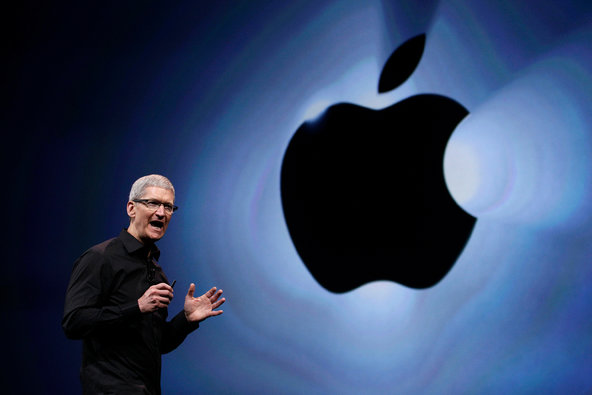 Eric Risberg/Associated PressTimothy Cook, the chief of Apple.
Eric Risberg/Associated PressTimothy Cook, the chief of Apple.
With a $145 billion cash hoard, Apple could acquire Facebook, Hewlett-Packard and Yahoo — and still have more than $10 billion left over.
Despite its uncommonly flush balance sheet, Apple borrowed money on Tuesday for the first time in nearly two decades. In a record bond deal, the company raised $17 billion, according to a person briefed on the deal, paying interest rates that rival those of debt issued by the United States Treasury.
Apple’s corporate-finance maneuver raises a riddle: Why would a company with so much cash even bother to issue debt?
The answer has a lot to do with the frenzied state of the bond markets. Companies are issuing hundreds of billions of dollars in debt to exploit historically low interest rates and strong investor demand for bonds as an alternative to money market funds and Treasury bills that paying virtually nothing.
“If you look at these big companies like Apple and Microsoft doing these big, low-cost bond offerings, it’s a way for them to raise money in an effort to create better returns for their shareholders,” said Steven Miller, a credit analyst at SP Capital IQ. “The bond markets are practically begging these corporations to issue debt because of how cheap it is to raise money.”
But Apple’s move also reflects the challenges of a highly successful business with a flagging stock price. In an effort to assuage a growing chorus of concerned and disappointed Apple investors, the company is issuing bonds to help finance a $100 billion payout to its shareholders. It will distribute most of that amount over the next two and a half years in the form of paying increased dividends and buying back its stock.
While Apple’s shareholders and analysts welcome the company’s financial tactics, they say that the maker of iPhones, iPads and iMacs must continue to innovate and fend off increasing competition.
“This is a substantial return of cash, and it’s the right thing to do on many levels,” said Toni Sacconaghi, an analyst at Bernstein Research. “But, ultimately, the company has to execute. This is no substitute for that.”
By raising cheap debt for the shareholder payouts, Apple will also avoid a potentially big tax hit. About two-thirds of Apple’s cash — about $102 billion — sits overseas in lower-tax jurisdictions. If it returned some of that cash to the United States to reward its investors, the company could have significant tax consequences.
“We are continuing to generate significant cash offshore and repatriating this cash would result in significant tax consequences under current U.S. tax law,” said Peter Oppenheimer, Apple chief financial officer, during an earnings call last week.
In some ways, the bond issue on Tuesday was made necessary by Apple’s tax strategies.
“They have been so successful with their tax planning that they’ve created a new problem,” said Martin A. Sullivan, chief economist at Tax Analysts, a publisher of tax information. “They’ve got so much money offshore.”
The $17 billion debt sale by Apple is the largest on record, surpassing a $16.5 billion deal from the drugmaker Roche Holding in 2009. Apple joins a parade of large companies issuing debt with astonishingly low yields. Last week, the shoe company Nike sold bonds that mature in 10 years that yielded only 2.27 percent. Last July, Bristol-Myers issued five-year debt yielding 1.06 percent. In November, Microsoft set the record for the lowest yield on a five-year bond, issuing the debt at 0.99 percent.
Despite Apple’s $145 billion cash pile, the credit-ratings agencies did not award the company their coveted triple-A rating, citing increased competition and a concern that its future product offerings could disappoint. Moody’s Investors Service gave the company its second-highest rating, AA1, as did Standard Poor’s, rating the company AA+. (The four companies awarded the highest credit ratings by both Moody’s and S.P. are Microsoft, Exxon Mobil, Johnson Johnson and Automatic Data Processing.)
“There are inherent long-run risks for any company with high exposure to shifting consumer preferences in the rapidly evolving technology and wireless communications sectors,” wrote Gerald Granovsky, a Moody’s analyst.
Apple’s less-than-perfect rating did not drive away bond investors on Tuesday. The offering generated investor demand well in excess of the $17 billion raised, according to person briefed on the deal. Goldman Sachs and Deutsche Bank led the sale of the issuance.
Desperate for returns in a yield-starved world, all types of investors — including individual, pension funds and mutual funds — are snapping up corporate debt. The demand appears to be insatiable: this year, through last Wednesday, a record $55 billion has flowed into mutual funds and exchange-traded funds that invest in corporate debt with high-quality ratings, according to the fund data provider Lipper.
The last time Apple sold debt was in 1996, when the Internet was in its infancy and sales of Apple’s niche computers were struggling. Facing an uncertain future and struggling with a weak balance sheet, Apple had a junk credit rating and was paying 6.5 percent on its debt.
Article source: http://dealbook.nytimes.com/2013/04/30/apple-raises-17-billion-in-record-debt-sale/?partner=rss&emc=rss